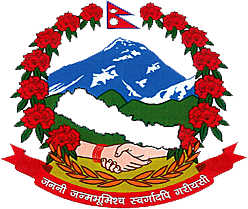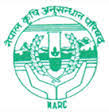NCRP at a glance
Introduction
National Cattle Research Program (NCRP) is one among the various commodity programs under the Nepal Agricultural Research Council (NARC), administered directly by the director for Livestock and Fisheries research. It has evolved from the Livestock Development Farm of the Department of Livestock Development and Animal Health after the establishment of Nepal Agricultural Research Council in 2048 B.S. (1991AD) and named as National Bovine Research Program (NBRP) at Khumaltar, Lalitpur. In 2069 B.S. (2013 AD) cattle commodity was separated from National Bovine Research Program (NBRP) and NCRP was formed. NCRP was shifted from Khumaltar to Rampur, Chitwan in 2071 B.S. (2014 A.D.). It is situated in the central region of Nepal (270 65′ N latitude; 840 35′ E longitude and 187 masl.) at Rampur, Chitwan. It has humid and subtropical climate with cool winter (2-3 oC) and hot summer (43 0C). The annual rainfall is over 1500 mm with a distinct monsoon period (>75% of annual rainfall) from mid-June to mid-September. This is 10 km west from the Bharatpur (district headquarter of Chitwan). NCRP complex extends in an area of 25 hectare of land.
Vision
To enhance the production and productivity of cattle for nutritional security and livelihood improvement of Nepalese people and be a leading research institute in the country.
Mission
Improving cattle production and productivity by conducting problem based, farmer oriented, participatory & systematic research and recommend innovative & adaptable technologies to farmers.
Goal
Livelihood of farming communities improved through research by increased livestock productivity and enhance the contribution of cattle in national economy.
Mandate
- Conducting research in areas of cattle feeding/nutrition, fodder/pasture, breeding, health, production & management and socio-economic aspects, suitable for various agro-ecological zones of country.
- Documentation, maintenance and update information on cattle research in Nepal.
- Verify and recommend adaptable technologies for dairy (cattle) sector transformation in the country.
- Develop and recommend suitable technologies related to milk production, collection, processing, milk product diversification and marketing.
- Publication of developed technologies on cattle and collaborations with extension agencies for their disseminations and easy adaptation by farmer.
- Collaboration with national and international research organizations, institutions and centers for research supports and specialization development.
- Evaluation, characterization, exploration, utilization and conservation of cattle germplasm.
- Assist in cattle breed registration and release.
- Determine, formulate and prioritize issues and strategies in short, medium and long term in national cattle research in the country.
- Assist in formulating and implementing the government policies for cattle sector development.
Objectives
- To generate, verify and recommend suitable adaptable technologies in feeding, breeding, production / management (husbandry) & health of cattle for various agro-ecological zones of the country.
- To document, maintain and update information on cattle research in Nepal.
- To generate, verify and recommend adaptable technologies in Post harvest and marketing sector.
- To determine, formulate and prioritize issues and strategies in short, medium and long term in national cattle research in the country.
- To establish, maintain and strengthen linkage with other national and international organization for collaborative and participatory research.
- Evaluation, characterization, exploration, utilization and conservation of cattle germplasm.
- To assist in cattle breed registration and release.
- To assist in formulating and implementing the government policies regarding cattle.
Achievements
- Fifty percent gene level of crossbred Jersey or Holstein-Friesian (HF) is suitable for the on-farm condition of mid hills. Age at calving, calving interval and milk yield of 50 % Jersey and HF was recorded (32.4 & 27.9 months), (13.8 & 17.7 months) and (1471 & 1836 liters/ lactation) respectively.
- Early weaned crossbred cattle calves at 4 months of age performed better than the calves weaned at 2 and 6 months of age. The age and body weight at puberty of the cross-bred calves weaned at 4 months of age was 12.33 months and 195.3 kg. Whereas the calves weaned at 2 and 6 months of age had puberty at 12.7 & 14.4 months of age and body weight at puberty were 169.5 and 148.02 kg respectively.
- Increased milk production in cows and better growth rate of forthcoming calves can be expected by steaming up diet during last two months of gestation.
- Calves can be raised successfully by replacing whole milk feeding with unconventional milk replacer after the age of 21 days. Feeding milk replacer based on buttermilk and whole milk saved Rs 2284 and 2141/- per calf respectively during four months rearing period.
- Induced lactation is possible in dry and infertile animal with the use of sex steroids. Estrogen (Estradiol 17 ß and) progesterone (4-pregnene-3, 20 dione) in the ratio of 1:2.5. It was more effective in terms of induction and average milk yield as compared to the hormone ratio of 1:1.
- Milk yield is affected significantly by the increased feeding frequency of lactating animals. Dividing the daily concentrate requirement of high yielding cattle (> 10 liters/day) into three parts and feeding them three times a day (7 a.m., 12 noon & 4 p.m.) produced an additional 495 liters of milk per lactation as compared with two times feeding (7 a.m. & 4 p.m.) 2268 liter/ lactation.
- Urea-mineral-molasses block (UMMB) feeding was economical for increased milk production in crossbred dairy cattle. Dairy cows supplemented with UMMB produced 1282.6 liters of milk as compared to the cows without supplementation (855.9 liters) in 140 days of study period.
- Early pregnancy diagnosis in bovine (30 days onward) from milk and blood serum has been established by ELISA technique.
- The quality forage based production system reduced the cost of milk production by reducing concentrate feed by 35% to 45%. Animals fed in certain feed regime (2 kg feed for maintenance extra for milk production) and rest dry matter supplied by combination of 50% non legume forage + 30 % legume forage + 20 % dry roughage per liter milk production cost as Rs. 19.46 in farm condition.
Researchers
- Mr. Devi P Adhaikari, Senior Scientist (S3)/ Coordinator- Livestock Products, Production and Management
- Mr. Bishnu Bahadur KC, Scientist (S2)- Livestock Products, Production and Management
- Dr. Uddav Paneru, PhD, Scientist (S2)- Animal Breeding and Genetics
- Dr. Sagun Malla, Scientist (S1)- Animal Nutrition and Feeding
- Dr. Shiva Hari Ghimire, Senior Technical Officer (T8)- Livestock Products, Production and Management
- Mrs. Durga Rawat, Technical Officer (T6) - Livestock Products, Production and Management
- Dr. Yagya Raj Pandeya, Technical Officer (T6), MVSc (Theriogenology) - Livestock Products, Production and Management
- Dr. Pratik Hamal, Technical Officer (T6)- Livestock Products, Production and Management
Contact Address
National Cattle Research Program,
Rampur, Chitwan
Tel: 977-56-591071, 591009 Fax: 977-56-591255
Email: ncrp@narc.gov.np
Website: www.ncrp.gov.np


